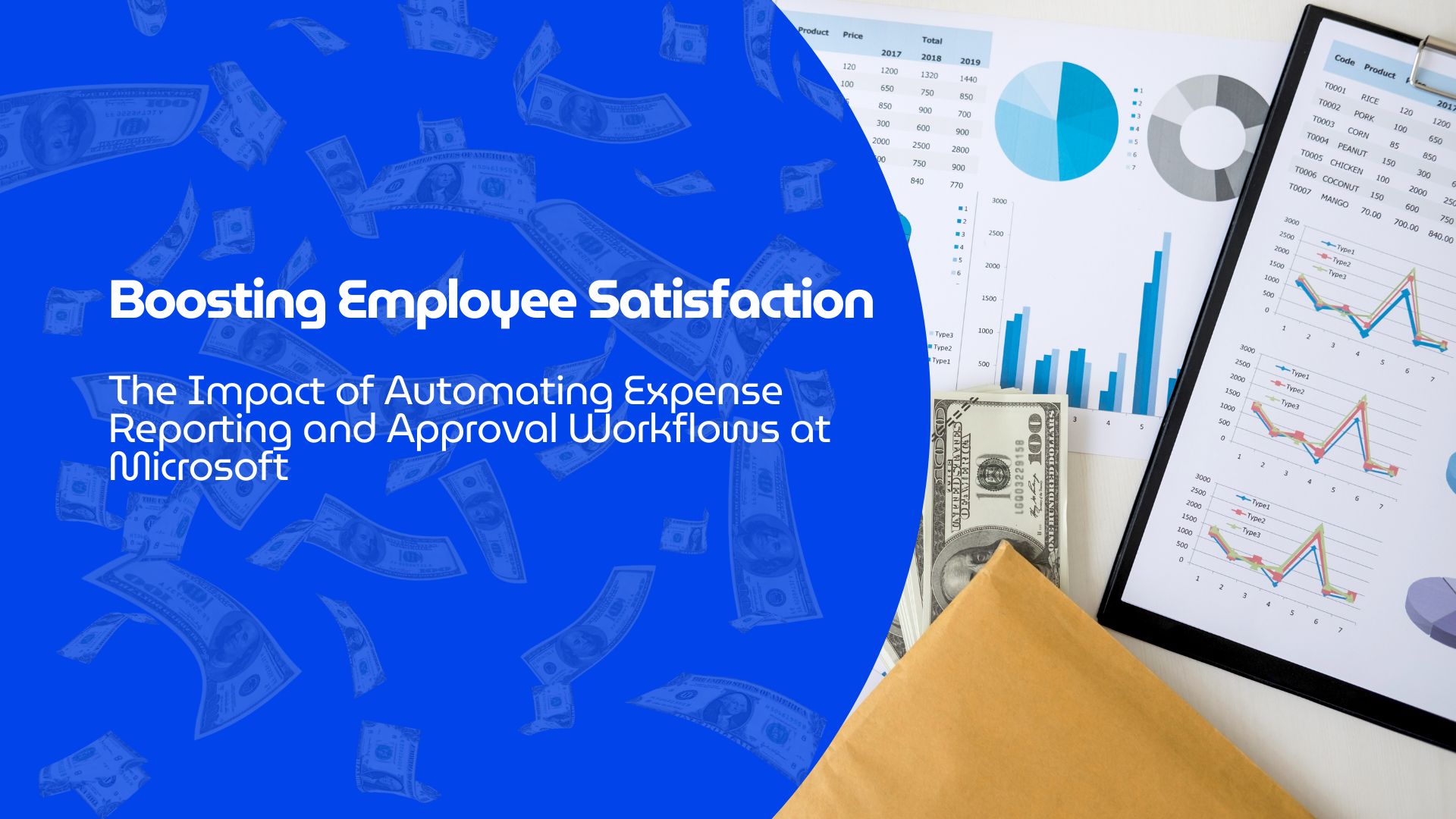In today’s corporate landscape, efficiency is not just a luxury; it’s a necessity. As businesses grow, managing operational tasks manually becomes increasingly cumbersome, leading to employee errors, delays, and frustration. One such area that can benefit from automation is expense reporting. Companies increasingly realize that streamlining the process through automated systems enhances productivity and employee satisfaction. Microsoft, one of the world’s leading technology companies, has taken this approach to heart, leveraging expense approval workflows to boost the overall employee experience.
This blog will explore how automating expense reporting at Microsoft transforms employees’ interactions with financial tasks and enhances business efficiency. Additionally, we will discuss how expense approval workflows are crucial in achieving smoother operations within large organizations.
The Problem with Traditional Expense Reporting
Before automation became the norm, expense reporting was time-consuming and often frustrating for employees. Microsoft, like many large corporations, used a manual process that involved employees filling out spreadsheets, attaching receipts, and submitting their reports for approval. The process often led to delays, inefficiencies, and frustration, especially when reports were rejected for minor errors.
In addition to being tedious for employees, the manual approach was error-prone, making it difficult for the finance department to maintain accurate records. Manual entry meant errors could go unnoticed for extended periods, and reconciling these errors took valuable time away from more critical tasks. These inefficiencies were even more pronounced with the global scale of Microsoft’s operations.
Enter Expense Approval Workflow Automation
To solve these challenges, Microsoft implemented expense approval workflows that allowed for more seamless and accurate expense reporting. These workflows provide a structured framework for submitting, approving, and reconciling expenses within the organization. By automating the entire process, Microsoft could eliminate the manual steps that led to errors, delays, and employee dissatisfaction.
An expense approval workflow streamlines the process, allowing employees to submit expenses directly into an automated system. From there, the system can automatically route the report to the appropriate manager for approval, ensuring all necessary documentation is in place. With pre-set rules and validations, the system checks for common errors, such as duplicate receipts or missing information, reducing the likelihood of report rejection.
Benefits of Automating Expense Reporting
- Improved Efficiency and Accuracy
One of the most significant benefits of implementing an expense approval workflow is improving accuracy and efficiency. By automating data entry and approval processes, Microsoft’s employees no longer must spend time filling out forms manually or tracking down missing receipts. The system automatically populates fields based on the expense category, reducing human error. The expense approval workflow also reduces the time finance teams spend reviewing and processing expense reports. With fewer manual interventions, reports are approved and reimbursed much faster, resulting in quicker turnaround times for employees.
- Enhanced Employee Experience
Automating the expense reporting process directly impacts the employee experience. Microsoft employees can now submit their expenses through a simple, user-friendly interface without worrying about errors, missing receipts, or delays. This creates a more pleasant and efficient experience for employees who no longer need to dedicate time and effort to administrative tasks. With an expense approval workflow, Microsoft’s employees can track the status of their reports in real-time, providing transparency and reducing uncertainty. Knowing when their report will be approved or reimbursed helps employees better manage their finances and creates a sense of control over their workflow.
- Reduced Administrative Burden
By automating the process, Microsoft’s finance team experiences a substantial reduction in administrative work. The automated expense approval workflow ensures that all reports are properly formatted and complete before reaching the finance department. This removes the need for finance personnel to manually review and correct errors, freeing time for more valuable tasks, such as financial analysis and forecasting. Additionally, automated workflows make it easier for finance teams to generate reports and maintain accurate records. Instead of manually compiling data, they can use the system to automatically generate expense summaries and dashboards, simplifying the tracking of expenditures and identifying potential discrepancies.
- Compliance and Policy Enforcement
Expense management comes with the added responsibility of ensuring compliance with company policies, tax regulations, and industry standards. By automating the process through an expense approval workflow, Microsoft can ensure that all expenses comply with internal policies. The system can automatically flag expenses that exceed set limits or fall outside the acceptable categories, prompting employees and managers to address these issues before submission. This system helps prevent policy violations and ensures that employees are aware of company policies before they submit their expenses. Microsoft creates a seamless process that promotes accountability and transparency by integrating company rules into the expense approval workflow.
- Increased Transparency and Control
Transparency is a significant concern for both employees and employers when it comes to expense reporting. Employees want to know when their reports will be processed and when they can expect reimbursement, while employers want to ensure that expenses are justified and compliant. With an expense approval workflow, both parties gain greater visibility into the process. Microsoft’s employees can easily track the status of their expense reports, knowing exactly where they are in the approval chain. This transparency reduces frustration and uncertainty, allowing employees to stay informed about the progress of their reports.
For managers, the automated system offers real-time access to approved and pending expenses, making monitoring spending easier and ensuring that the company stays within its budget. The expense approval workflow also allows managers to review and approve reports more quickly, improving decision-making and cash flow management.
The Technology Behind Expense Approval Workflows
The backbone of an effective expense approval workflow is the technology that powers it. Like many companies, Microsoft uses integrated software solutions to manage its expense reporting process. These platforms can integrate with existing accounting systems, HR tools, and other enterprise resource planning (ERP) systems, ensuring that expenses are recorded and tracked accurately.
Popular expense management software, such as Expensify, Concur, and Zoho Expense, is often used with custom-built workflows to streamline the approval process. These platforms offer various features, such as receipt scanning, automated categorization, and policy enforcement, to simplify the reporting process.
A robust expense approval workflow requires the ability to integrate with other business systems. By syncing data with payroll, accounting, and tax systems, Microsoft can ensure that employees are reimbursed promptly and that all expenses are accounted for in the company’s financial records.
Challenges and Considerations
While automating expense reporting offers numerous benefits, it also has some challenges. One potential challenge is ensuring employees are adequately trained to use the new system. Microsoft has provided training resources and support to ensure employees understand how to use the expense approval workflow effectively.
Another consideration is ensuring the system is flexible enough to accommodate changes in company policies, tax regulations, or other external factors. The expense approval workflow must be adaptable and scalable, handling a wide range of expense types and reporting requirements as Microsoft’s business grows.
Automating the expense reporting process has proven to be a game-changer for Microsoft, helping streamline administrative tasks, reduce errors, and improve the overall employee experience. Integrating an expense approval workflow has allowed the company to maintain compliance, ensure policy enforcement, and speed up the approval process—all while reducing the burden on employees and the finance department.
The benefits of this automation go beyond improved efficiency; it creates a more transparent, enjoyable experience for employees and fosters a culture of accountability and trust. By embracing technology-driven solutions like expense approval workflows, Microsoft is not only simplifying its operations but also empowering its employees to focus on what matters most—innovation, collaboration, and growth.
Sources:
- Forbes – https://www.forbes.com
- Business News Daily – https://www.businessnewsdaily.com
- Harvard Business Review – https://hbr.org
- Gartner – https://www.gartner.com
- TechCrunch – https://techcrunch.com





